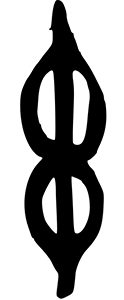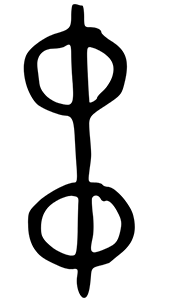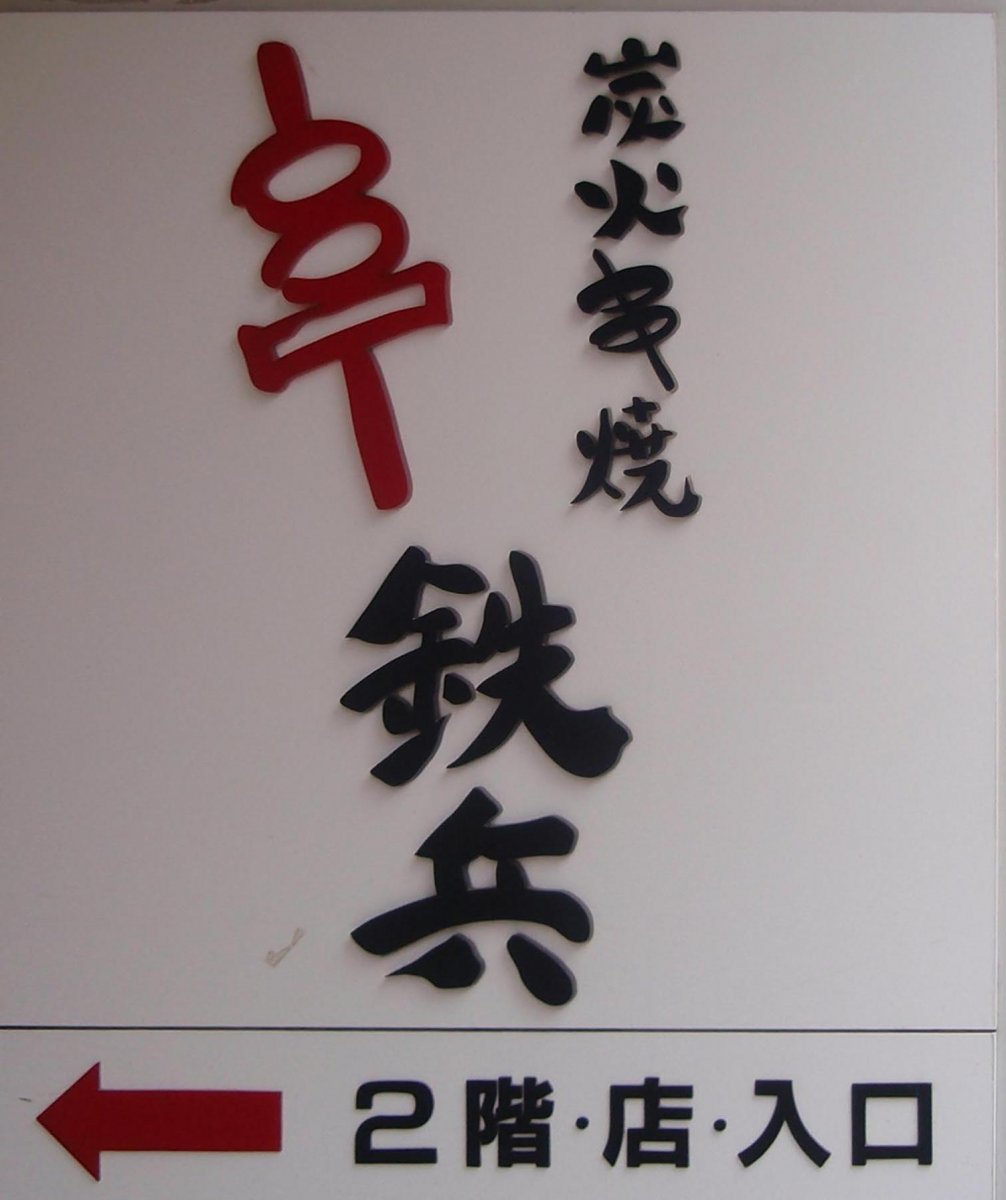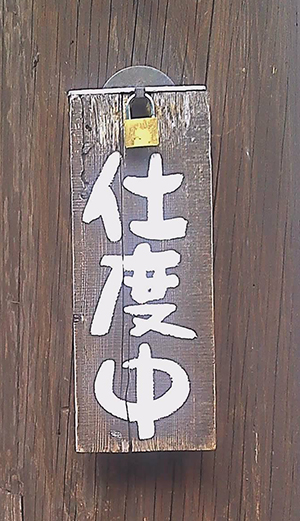2. The "Rod" Radical: |
Supposedly, if you spare the rod, you'll spoil the child. Despite that extremely questionable rule of thumb, the ancient Chinese decided to use the "rod" sparingly in designing characters. That is, the "rod" radical | is on duty in only two Joyo kanji:
中 (55: middle; in; among; during; throughout; China; to hit the target)
串 (1993: skewer)
Of course, we can find this vertical line in scads of other characters, including 下 (7: below), 弟 (177: younger brother), and 旧 (648: old). But in those contexts, | serves as a mere component, not as the on-duty radical.
We might think we're spotting | when that single stroke is actually part of larger radicals, such as these:
亻 (a variant of radical 9, the "person" radical 人)
儿 (radical 10: "legs")
刂 (a variant of radical 18, the "sword" radical 刀)
十 (radical 24: "cross")
卜 (radical 25: "katakana to")
土 (radical 32: "earth")
士 (radical 33: "samurai")
小 (radical 42: "little")
山 (radical 46: "mountain")
巾 (radical 50: "cloth")
干 (radical 51: "dry")
木 (radical 75: "tree")
牛 (radical 93: "cow")
玉 (radical 96: "jewel")
Alternatively, one might confuse | with these similar-looking radicals:
乚 (radical 5: "fishhook")
亅(radical 6: "barb")
You get the idea. Whenever a line plunges down through a character, it's probably not a true rod.
Why Are There Rods in 中 and 串?
So why do 中 and 串 contain rods? Here are etymologies from the newer edition of Henshall:
中 (55: middle; in; among; during; throughout; China; to hit the target)
Henshall doesn't really explain why the strokes of 中 make it mean what it does. He does say that the character essentially means "middle, inside" and by extension "to hit the center." With that he might be implying that the radical goes through the heart of the rectangle, making the extended sense of 中 possible.
串 (1993: skewer)
This shape was originally the pictograph of items such as "shell currency on a cord." One scholar sees the items as being on a cord or stick. Henshall calls "to pierce, penetrate" extended senses of the character, along with "skewer."
I eagerly consulted Sears's page of old character shapes, hoping to see seashells strung on a cord, but his early images of 串 are too simple to reflect the detailed shapes of mollusks:


© Richard Sears
Bronze-script versions of 串.
Kanjigen tells us that the | radical has no inherent meaning. It's nothing but a line. Therefore, looking to etymologies for the role of the rod is useless!
What Do the Japanese Call the "Rod" Radical?
The Japanese refer to the | radical as ぼう or たてぼう, names that correspond to these words:
棒 (ぼう: rod)
縦棒 (たてぼう: vertical rod)
Compare these with 撥ね棒 (はねぼう: rod with a hook), the name of 亅(radical 6: "barb").
Fun with Form
Whereas 串 once depicted a series of shells, it now seems a most obvious representation of food on a stick. This likeness has inspired some sign makers to have fun, as in this case:

A Tokyo restaurant named 鉄兵 (てっぺい) uses 炭火 (すみび: charcoal fire) for 串焼き* (くしやき: grilling on a skewer; spit-roasting). The sign tells us this much, but the red drawing says it all.
In this Singapore sign, the 串 does double duty, representing both a skewer and the letter b! Clever!
This casual sign outside an izakaya (pub) in Kawasaki (in Kanagawa Prefecture, south of Tokyo) features a picture of the sweet named 団子 (だんご: dumplings made from rice flour) on a stick, reminding me of the range of what the Japanese like to skewer. Though the middle sign omits any mention of 団子, it does contain these words:
串焼き魚に
Grilled skewers of fish
魚 (さかな: fish)
地酒でじっくり
Take your time (enjoying) local saké
地酒 (じざけ: local saké);
じっくり (without rushing)
The sign to the right bears an image of a fish but says nothing specific about the menu:
炙里の料理は創作料理
Aburi cuisine is creative cuisine
炙里 (あぶり: restaurant name);
料理* (りょうり: cuisine); 創作 (そうさく: creative work)
The non-Joyo 炙 means "to roast" and is quite a clear pictograph of that process. Kanjigen says that the character depicts "meat" (月) over "fire" (火). Isn't it great when things make sense in the kanji world?!
As for the left-hand sign, it presents us with wordplay:
すてーきなステーキ
Splen〜did steaks
ちゃーんとチャーハン
Prop〜erly (cooked) fried rice
チャーハン (炒飯: fried rice), where 炒 is non-Joyo
In each case, a sound in the first word has been elongated so that the hiragana terms replicate (or come close to replicating) the katakana words. Normally, すてき (素敵: splendid) and ちゃんと (properly) have no stretched-out parts. In addition to fun with form in other signs, we now have fun with phonetics!
I didn't find many playful presentations of 中, perhaps because the meaning isn't as inherently fun as a skewer somehow is or maybe because the 中 shape doesn't inspire much creativity. But I'll share examples of 中 in unexpected fonts.
The font on this sign makes it seem like a whole lot of fun that the establishment is currently closed. The 只今 (ただいま), where the first kanji is non-Joyo, means "right now." The second line presents the reason; 準備中 (じゅんびちゅう) means "in preparation; (shop) not yet open for business."

Many thanks to Lutlam for this last photo. (Except for the Sears images, I took all the others.) The font here is relaxed, and even the wording is unusual. Whereas 準備中 is the normal way of conveying that an establishment is momentarily closed, this sign instead says 仕度中 (したくちゅう: in preparation; not yet open). That's not the only oddity; 仕度 (したく: preparation; arrangements) is the less-common rendering of a term typically written as 支度.
One more instance of an unexpected 中 shape appears in the last photo in Radical Note 104 on 疒, the "sickness" radical.
